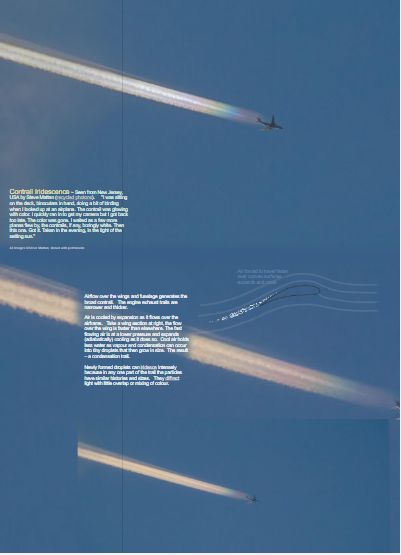Contrail Iridescence - OPOD
Contrail Iridescence: A Captivating Atmospheric Phenomenon
Contrail iridescence, also known as iridescent contrails, is a mesmerizing optical phenomenon that can be observed in the skies. It occurs when the contrails left behind by airplanes display vibrant colors, resembling a beautiful rainbow. While contrails are typically white, there are instances when they exhibit stunning iridescence, captivating the eyes of those fortunate enough to witness it.
The formation of contrails is closely linked to the airflow over the wings and fuselage of an aircraft. As air flows over the airframe, it undergoes expansion and cooling. For instance, when considering a wing section, the air flowing over the wing moves faster than in other areas. This faster-moving air experiences lower pressure and expands adiabatically, resulting in a cooling effect. As the air cools, its capacity to hold water vapor decreases, leading to condensation.
During the condensation process, tiny droplets form and subsequently grow in size, creating what we commonly refer to as contrails. These newly formed droplets have the potential to produce intense iridescence due to their similar histories and sizes. When light passes through these droplets, it undergoes diffraction, resulting in the separation of colors. Unlike a typical rainbow where colors blend together, contrail iridescence showcases distinct bands of vibrant hues with little overlap or mixing.
The phenomenon of contrail iridescence is a delicate interplay of atmospheric conditions and the properties of the droplets within the contrail. To observe this captivating sight, certain factors must align perfectly. Here are a few important points to consider:
-
Light Source: Contrail iridescence is most visible when illuminated by a low-angle light source, such as the setting sun. The unique angle of the sun's rays creates an optimal environment for the diffraction of light within the contrail, enhancing the iridescent effect.
-
Contrail Thickness: The thickness of the contrail plays a role in determining the intensity of iridescence. Thicker contrails tend to exhibit more pronounced colors, while thinner ones may display more subtle hues.
-
Particle Uniformity: The droplets within the contrail must be relatively uniform in size and history to produce a vivid iridescent display. Variations in droplet size or composition can diminish the intensity of the colors observed.
-
Viewing Angle: The angle at which an observer views the contrail affects the visibility of iridescence. Optimal viewing angles are often perpendicular or nearly perpendicular to the contrail itself, allowing for the greatest dispersion of colors.
Contrail iridescence is a transient phenomenon, often lasting only for a brief period. The ever-changing atmospheric conditions, including wind patterns and humidity levels, contribute to the ephemeral nature of this captivating display. It is not uncommon for observers to miss the opportunity to capture contrail iridescence on camera, as was the case for Steve Mattan during his birdwatching session in New Jersey, USA.
While contrail iridescence is undoubtedly a visually stunning phenomenon, it is important to note that its occurrence is relatively rare. The perfect combination of atmospheric conditions and specific properties of the contrail must align for iridescence to manifest. However, when these elements come together, the result is a breathtaking display of nature's beauty in the skies above.
In conclusion, contrail iridescence is a captivating optical phenomenon that occurs when certain conditions are met during the formation of contrails. It is a result of the diffraction of light by uniform droplets within the contrail, leading to the separation of colors and the creation of vibrant bands of hues. While observing this phenomenon can be a challenge due to its fleeting nature, those fortunate enough to witness it are treated to a breathtaking display of iridescence in the sky. So, keep your eyes on the skies and be ready to capture the magic of contrail iridescence if it ever graces the heavens above you.

Contrail Iridescence ~ Seen from New Jersey, USA by Steve Mattan (recycled photons). "I was sitting on the deck, binoculars in hand, doing a bit of birding when I looked up at an airplane. The contrail was glowing with color. I quickly ran in to get my camera but I got back too late. The color was gone. I waited as a few more planes flew by, the contrails, if any, boringly white. Then this one. Got it. Taken in the evening, in the light of the setting sun."
All images ©Steve Mattan, shown with permission
Airflow over the wings and fuselage generates the broad contrail. The engine exhaust trails are narrower and thicker.
Air is cooled by expansion as it flows over the airframe. Take a wing section at right, the flow over the wing is faster than elsewhere. The fast flowing air is at a lower pressure and expands (adiabatically) cooling as it does so. Cool air holds less water as vapour and condensation can occur into tiny droplets that then grow in size. The result – a condensation trail.
Newly formed droplets can iridesce intensely because in any one part of the trail the particles have similar histories and sizes. They diffract light with little overlap or mixing of colour.
Note: this article has been automatically converted from the old site and may not appear as intended. You can find the original article here.
Reference Atmospheric Optics
If you use any of the definitions, information, or data presented on Atmospheric Optics, please copy the link or reference below to properly credit us as the reference source. Thank you!
-
<a href="https://atoptics.co.uk/blog/contrail-iridescence-opod/">Contrail Iridescence - OPOD</a>
-
"Contrail Iridescence - OPOD". Atmospheric Optics. Accessed on December 22, 2024. https://atoptics.co.uk/blog/contrail-iridescence-opod/.
-
"Contrail Iridescence - OPOD". Atmospheric Optics, https://atoptics.co.uk/blog/contrail-iridescence-opod/. Accessed 22 December, 2024
-
Contrail Iridescence - OPOD. Atmospheric Optics. Retrieved from https://atoptics.co.uk/blog/contrail-iridescence-opod/.